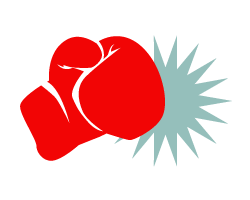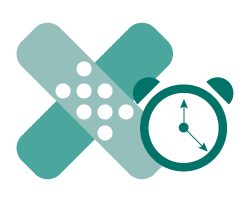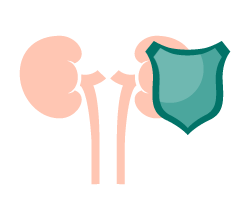What Is Sweat?
On its own, sweat is an odorless secretion, consisting mainly of water, ammonia, sugar, urea, and salts.
We sweat when our internal temperatures become hotter than normal.
Sweat glands release liquid from the body. As this liquid evaporates, there is a cooling effect. This process is known as perspiration.
The odor we get from sweat happens after it reacts with the bacteria on the skin.
Composition of Sweat
Sweat is mostly water. Dissolved in the water are trace amounts of urea (waste products) and minerals including sodium, potassium, calcium and magnesium.
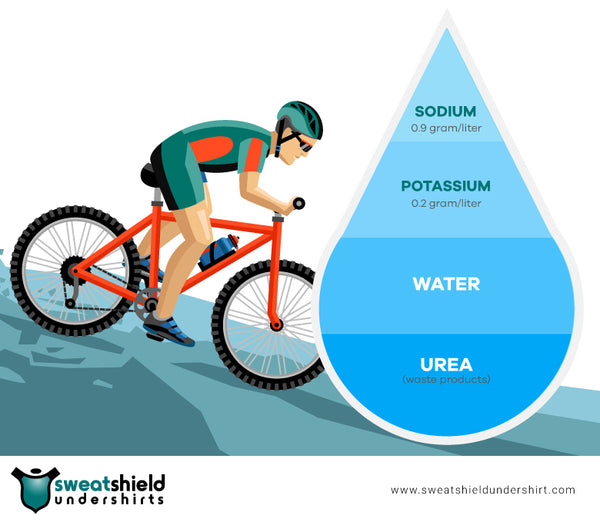
Where Does Sweat Come From?
Sweat is generated by thermo-sensitive neurons controlled by the hypothalamus.
When the brain triggers a sweat response to rising heat, high energy molecules turn to vapor on the skin, easing the body back to normal temperature.
Although people commonly sweat on their palms, feet, and underarms, sweat can occur from any other part of the body due to different reasons.
The human body has approximately 2 to 5 million sweat glands.
Check out this video on the purpose of sweat from the educational team at TED-Ed and the creators of TED Talks.
Why Do People Sweat?
Aside from temperature regulation, different physiological reasons can cause sweating.
During physical exertion or hot weather, the nervous system automatically triggers sweat responses from the eccrine glands.
On the other hand, the apocrine glands are linked to emotional sweating. It is the body’s response to sudden or perceived danger, also known as the fight or flight response.
An average person sweats up to 5.7 liters per day.
Very active people can produce as much as 15 liters of sweat in one day, depending on the climate and the level of physical activity.
What Determines How You Sweat?
Exercise
The more physical activity you engage in, the higher your chances of increasing your body temperature.
Note: Two people doing the same level of exercises can still sweat differently. Studies indicate that due to their higher aerobic and cardiovascular endurance levels, athletes tend to sweat sooner and more efficiently.
Genetics
People tend to sweat in relation to their family history. Excessive sweating, for example, is believed to be a genetic trait.
Gender
Men and women have the same biologically designed glands, but studies have found that men not only sweat more “efficiently”, but they also sweat slightly more than women.
Bodyweight
Aside from cardiac endurance levels, overweight people may sweat more because their bodies need to use more energy to accomplish daily biological functions. In addition to that, more body mass requires more energy to cool down.
Body fat acts as insulation. Therefore, an overweight person may feel hotter, sweat more profusely, and take longer to cool down compared to a leaner person.
Sweat gland placement
The different types of sweat glands and their distribution influence where on the body people sweat as well as how much they sweat.
Acclimatization
People who live in tropical climates or those who spend a considerable amount of time outdoors tend to acclimatize to heat faster and sweat far more efficiently.
Gustatory sweating
This type of sweating occurs when a person sweats simply at the thought of food, during a meal, or immediately after eating.
Diet
Some foods have a thermogenic effect on people. This means that they inadvertently cause rising temperatures, making certain people sweat slightly more during, or soon after taking certain drinks or meals.
What Different Types of Sweat Mean
Between 1 and 3% of the total American population deals with incidents of excessive sweating. The condition is known as hyperhidrosis.
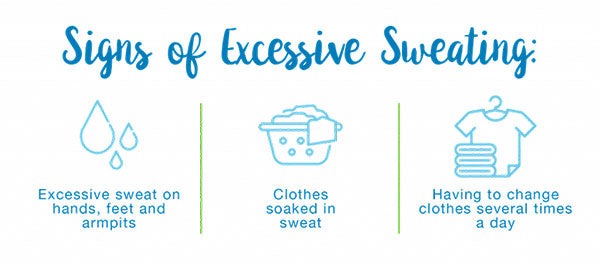
Image source: Pinnacle Skin
Here we’ve provided some answers that could uncover why a person experiences excessive sweating. A few examples include:
Cold sweats: Caused by stressful situations. This kind of sweating happens even during normal temperatures. It is sometimes followed by bad odor and sweat stains.
Night sweats: These are severe hot flashes that only happen at night time. They are mostly linked to women in menopause, but other conditions can also cause hot flashes.
Puberty: At the onset of puberty, the apocrine glands are activated. This can cause sudden bouts of both sweating and body odor in some young teens.
Primary Hyperhidrosis: Some people are more predisposed to sweat a little more than others. This is known as primary or focal hyperhidrosis. It usually happens on the palms, feet, face, and armpits. It also happens from early childhood.
Secondary Hyperhidrosis: This condition begins in adulthood, and usually happens as a result of certain medical conditions or medications. The sweat occurs on large surface areas of the body. Secondary hyperhidrosis requires diagnosis and medical follow up.
Hypohidrosis: In special cases sweat glands malfunction, which leads to a complete lack of sweating. This is a serious condition that requires medical attention, as it increases a person’s chances of overheating.
You’re Not Alone
- Have you ever experienced excessive sweating? Read more
- Have you ever woken up in the middle of the night covered in sweat? Read more
- Have you ever tried a sweat proof undershirt before? Read more
- Have you ever been terrified after Googling your own symptoms? Read more
- Do you have a trusted method of dealing with excessive sweat? Read more
What is Causing Your Excessive Sweating?
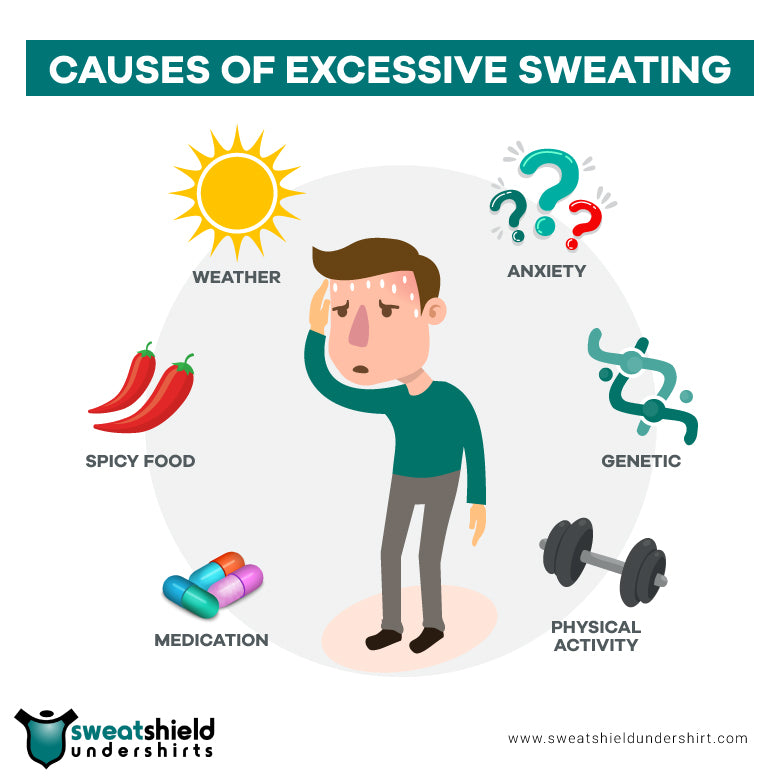
Genetics: Currently there is no known cause for primary hyperhidrosis. It’s simply overactive sweat glands. There is some research that suggests that this condition is genetic and heritable.
Anxiety: It is important to note that anxiety and hyperhidrosis are connected in two distinct ways.
Firstly, anxiety can cause secondary hyperhidrosis, which is defined as excessive sweating as a result of another underlying issue or factor.
Secondly, both primary and secondary hyperhidrosis can cause anxiety in those that suffer from excessive sweating.
Medication: Many drugs and over-the-counter medications can cause a person to experience excessive sweating; this is secondary hyperhidrosis.
People taking these medications can experience discomfort, anxiety, and embarrassment from the resultant excessive sweating.
The experience can also leave those on medications that cause excessive sweating to experience heat exhaustion, dehydration, and dry mouth.
Underlying Health Issues: Secondary hyperhidrosis can be brought on by many different health issues and diseases.
It is therefore important to speak with a certified healthcare professional if you experience several instances of excessive sweating within a short time.
Your doctor will be able to help you in ruling out any major health conditions that are known to cause excessive sweating.
Menopause: For women 40 and above, hyperhidrosis can be a result of hormonal changes associated with perimenopause and menopause.
With the help of a doctor, women experiencing perimenopause or menopause can determine an appropriate course of action to decrease symptoms like night sweats, hot flashes, and excessive sweating.
Treatment can range from hormone therapy to clothing designed to keep the body cool and dry in the event of a sweating episode.
Food: Certain foods, such as spicy peppers, can cause you to sweat while you’re eating or shortly thereafter.
Peppers contain a chemical called capsaicin, which triggers the nerves in your body to feel warm. This results in the body sweating in order to cool itself down.
Highly acidic or sugary foods can make your body produce more sweat as well. In addition, foods that are consumed at high temperatures can also cause the body to sweat in order to lower your overall temperature.
Weather: No surprise here, hot and humid temperatures can cause your body to produce sweat to maintain a healthy core temperature.
In hot and humid climates it is important to drink enough water to avoid dehydration or heat exhaustion as a result of excessive sweating.
More: If you are experiencing excessive sweating, seemingly without cause, it is important to visit your doctor to determine the cause and best treatment options available to you.
Types of Sweat Glands
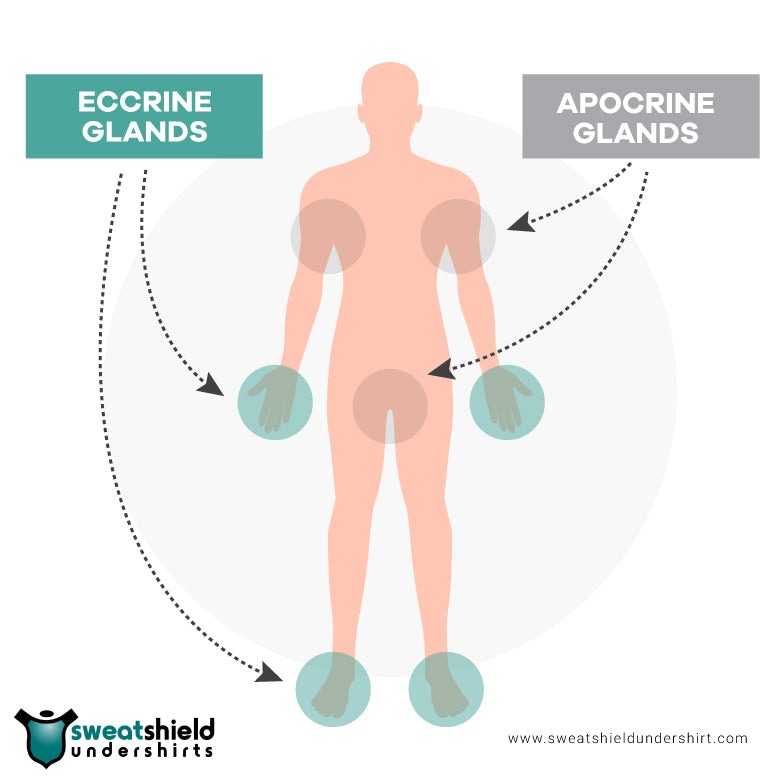
Eccrine Glands
Eccrine glands are found all over the skin’s surface. They are, however, mainly concentrated around the forehead, palms, feet, and armpits.
Sweat from eccrine glands is primarily water-based. Therefore, it does not produce an odor.
Apocrine Glands
Apocrine glands are usually present in hair follicles rather than the pores of the skin. They are mainly concentrated around the eyelids, ear canal, and groin areas.
Apocrine glands do not develop until the onset of puberty.
People often release sweat from apocrine glands in times of stress or anxiety. The sweat released usually has a milky appearance.
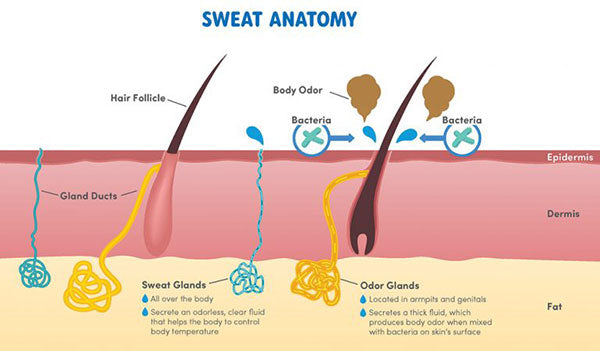
Image source: Chicago Dermatology
Understanding Different Types of Sweat Stains
Sweat stains used to be a huge problem for “excessive sweaters” because they can be impossible to get rid of.
The good news is, sweat stains no longer have the upper hand.
To appreciate how sweat proof undershirts work, one needs to understand how sweat stains occur.
Wet Ring Stains
After the moisture from your sweat evaporates, it dries on your clothes. This is called a wet ring.
They usually appear within minutes of sweat appearing. Sometimes they form in spite of deodorant or antiperspirant use.
Wet rings are especially visible on light-colored shirts like soft blue, beige, or white.
Yellow Sweat Stains
The longer a wet ring stain is left alone, the higher the chances of it developing into a phenomenon more difficult to deal with: yellow stains.
Yellow stains happen when sweat mixes with both bacteria and antiperspirant.
White Deodorant Stains
White deodorant stains are caused by a combination of sweat and deodorant residue transferred from your skin to the shirt.
This type of stain sometimes carries over even after washing and drying. It is best to deal with it as soon as you remove the clothes.
Natural Remedies to Manage Excessive Sweating
There are no conclusive studies that either validate or invalidate the effectiveness of natural remedies as a treatment for excessive sweating.
Regardless, many people use natural methods to solve various ailments. Some of them have been passed down for centuries.
Finding the right natural treatment may be time-consuming. Similarly, one person’s successful treatment may not work for another. In most cases, a combination of treatments may be needed for success.
Natural remedies can have a powerful effect. Disclose all used products to your doctor to avoid potentially dangerous contraindications with modern medicine.
Natural solutions for excessive sweating include:
- Chamomile
- Valerian root
- St. John’s Wort
- Acupuncture
- Hypnosis and other relaxation techniques.
- Sage tea/tablets
- Biofeedback
Click for more information on natural solutions and biofeedback.
Myths for Fixing Excessive Sweating
Other natural strategies for managing the effects of hyperhidrosis are:
Breathable clothes: Wearing breathable clothing reduces the chances of excessive heat absorption.
Wearing a sweat proof undershirt is a great solution for stopping sweat marks from appearing on outer garments.
Light-colored fabrics: Darker clothes absorb heat while lighter colored clothes act as reflectors against harsh sunlight. This is particularly true for hot climates.
Complex prints and dark colors can, however, help reduce the appearance of sweat stains.
Aluminum antiperspirants: Regular deodorants can be inefficient against hyperhidrosis. Aluminum acts by blocking sweat glands.
This means that while the body still produces sweat, the moisture does not ultimately reach the skin’s surface. Always apply on a clean and dry underarm.
Diet changes: Avoid foods that cause metabolic heat reactions in the body. These include spicy foods, alcohol, caffeine, and garlic. Click to learn more.
Proper hydration: Staying well-hydrated helps keep body temperatures down. This is particularly important during hotter seasons.
Besides drinking water, there are other strategies you can use to keep your body hydrated.
Medical Treatments for Excessive Sweating
Some cases of excessive sweating could, in reality, be pointing towards undetected diseases or side effects to some medications.
These are some medical treatments used to manage secondary hyperhidrosis (after confirmed diagnosis):
- High-strength prescription antiperspirants and creams
- Prescription-only oral medications that block the sweat glands
- Antidepressants
- Botox injections lasting between six months to a year.
A person usually needs several injections for this treatment plan to work, but the highest success rates of eliminating hyperhidrosis are from Botox treatments. - Surgery, for extreme cases. A person can either have complete sweat gland removal, nerve surgery, or microwave therapy.
Unbearable Complications from Hyperhidrosis
Choosing the Right Sweat Proof Undershirt
Sweat proof undershirts do not keep people from sweating.
But thousands of people depend on them to stay dry, no matter what sweaty situations arise in a day.
Here are the two main principles sweat proof undershirts are built around:
- Sweat protection - keeping the body cool
- Underarm protection - no sweat stains

The fabric used to design sweat proof undershirts focuses on breathability. This is what helps keep the body cool.
By using micromodal fabric, which is 50x more absorbent than cotton, we can guarantee that our shirts will keep you sweat mark-free all day.
When people sweat, the moisture is absorbed into the sweat proof fabric to prevent sweat stains from getting to the outer layer of clothing.
Our undershirts specialize in comfort and convenience, backed by ten years of dedicated research and technology.
We offer a range of choices for both women and men. Because everyone deserves to look, feel, and be their best version - all day, every day.
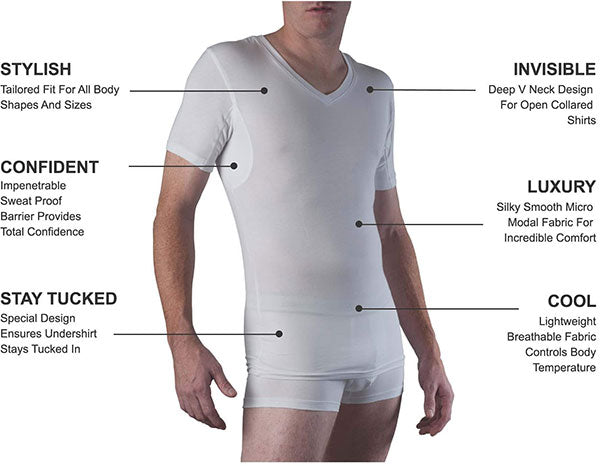
Discover more about Sweatshield Undershirt's Sweat Proof Technology
Men’s V Neck
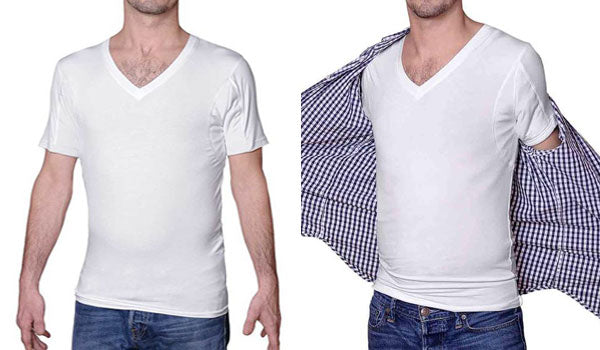
Men's Sweat Proof V-Neck Undershirt from Sweatshield Undershirts
Our Original Design, Still a Customer Favorite
We’re 10 years into our journey to help provide relief from sweaty situations and this shirt has been with us the whole ride.
Our keep cool technology ensures you stay comfortable and confident all day while keeping embarrassing sweat marks away.
Our micromodal fabric is soft to the touch and feels like an expensive garment. You can wear this shirt all day and trust that you’ll stay dry and look good the entire time.
Whether you’re making a presentation in the office, on an exciting date, or with your friends on the golf course, our sweat-proof barrier will keep you dry.
Our V-neck undershirt is designed to be completely impenetrable no matter the situation.
Click to get yours now.
Women’s Scoop Neck

Women's Sweat Proof Scoop Neck Undershirt from Sweatshield Undershirts
Feel Great, Look Great.
We are so proud of our women’s design for its amazing versatility. It’s easy to layer, comfortable and will keep you feeling confident and looking great.
Our scoop-neck design allows you to layer this piece under your favorite wardrobe staples.
You can trust our sweat stopping technology to banish sweat marks, keeping you cool and dry all day long.
These shirts look and feel expensive and you can rely on them to keep you comfortable and confident the entire day.
Get yours now.
| Sweatshield Undershirts | Ejis | NanoDri | |
|---|---|---|---|
| Wide Color Range | Yes | Yes | Yes |
| Natural Fibre | Yes | Yes | Yes |
| Micromodal Fabric | Yes | No | No |
| Price | $26 | $27.49 | $39.95 |
Frequently Asked Questions
How do Sweatshield Undershirts work?
Our products work by absorbing sweat and keeping it locked in with special keep-cool technology, 10 years in the making.
Are Sweatshield Undershirts moisture wicking?
NO! Moisture wicking is the process of taking sweat from the inner layer and moving it to the outer layer. We don’t want this to happen as it will result in wet marks on your outer clothing.
How do I care for my Sweatshield product?
We recommend machine-washing your products at low temperatures. Then laying them flat to dry or hang drying them. This allows them to keep their crisp shape.
How long will the product last?
Most customers find that our products last at least a year.
What is your return policy?
Any item can be returned within 30 days of purchase. More information on returns and refunds here.
Shop Our Entire Line: Stop Sweating Now
Our Customers Trust the Sweatshield Difference
More than 20,000 people in 70 countries trust Sweatshield Undershirts.
Join Our Community and Redeem Points
We have an array of ways to thank you for being a loyal and satisfied customer.
Have a friend who you think will enjoy our products? Refer Sweatshield Undershirts to them and you both win. Your friend will receive a coupon for $10 off their order of $50 or more. And when your friend spends over $50, we will reward you with enough points for a classic V-Neck or Crew Neck Sweat Proof Undershirt or a Women’s Scoop Neck Sweat Proof Undershirt.
Join our everyday rewards program and earn points for every dollar you spend and every friend you refer to us. We even give you points on your birthday, what’s not to love?
Click to sign up.
Photo: Freepik




